Freshly dug carrots, brilliantly sweet and oh so crunchy, are among the most rewarding moments of my childhood garden.
I especially loved the carrots twisted, spiraling around one another.
Indeed, my first carrots were darling but would never have flown at a farmer’s market. It’s true: Straight carrots that are long strong are impressively challenging to grow, so often surrounded by weeds and accompanied by frustration.
Here are keys I’ve learned across the years to grow root crops — and especially carrots and parsnips — with confidence:
3 Keys to Increase Carrot Germination
1. Prepare Soil Well
A word to the wise: If you don’t prepare your soil well, nothing else matters.
Carrots love deep, rich, well-drained soil, the looser the better. If you’re not tilling, snag a fork and work the soil well at least eight inches down, incorporating organic matter like compost or our granular, slow-release organic fertilizer throughout the soil. Light, loose soil encourages roots to lengthen; rich soil encourages the roots to stay straight.
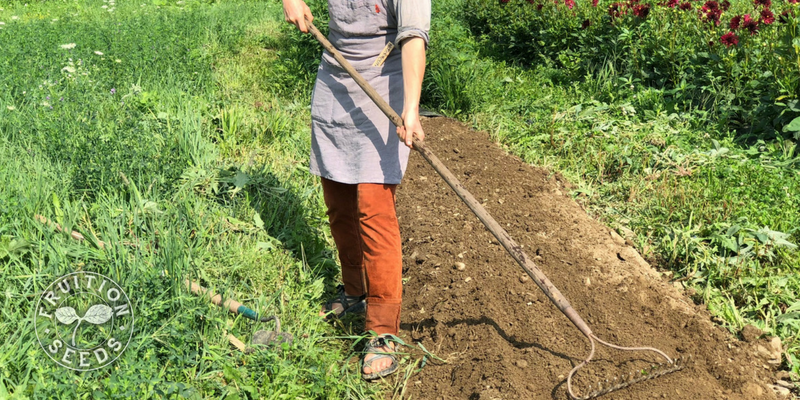
‘A stitch in time saves nine’ is perhaps never more true than when prepping soil for carrots.
Sowing seeds into moist soil, neither too wet or too dry, sets you up for success. If we can time our sowing just before a rain shower, so much the better.
We sow our carrot seeds two seeds per inch in long trenches eighteen inches apart. Before we cover and tamp down our trench, we’ll sow a single radish seed every six inches. These radishes help mark the row, since the slow-germinating carrots often take two weeks or more while the radishes are up in less than a week. These ‘marker’ radishes allow us to weed around our carrot rows with greater confidence, even before the carrots have emerged. Plus, they’re delicious! Just be sure you use a ‘classic’ radish with a quick three weeks to maturity rather than a watermelon radish, daikon or other root that may emerge quickly but won’t be so quick to mature.
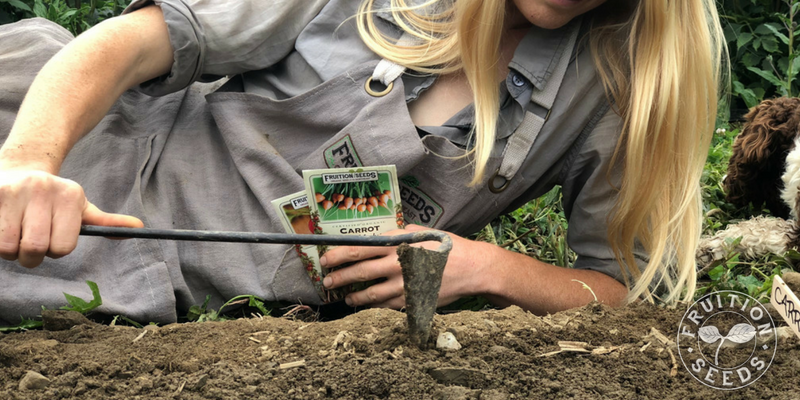
Sow a single radish seed every six inches as you sow your carrots! Their early emergence allows you to see and weed the bed well even with carrot’s long germination time.
2. Provide Ample, Even Moisture
[Floating Row Cover is Fabulous]
Carrots often take two to three weeks to germinate, depending on soil temperature. Parsnips take even longer. If the soil around them even remotely dries out before they’ve really established, they don’t stand a chance. Sometimes the weather might offer just the right moisture, but we don’t count on it. Instead, we provide ample, even moisture for our roots to germinate with a single layer of floating row cover to both mitigate moisture and raise the soil temp, hastening germination.
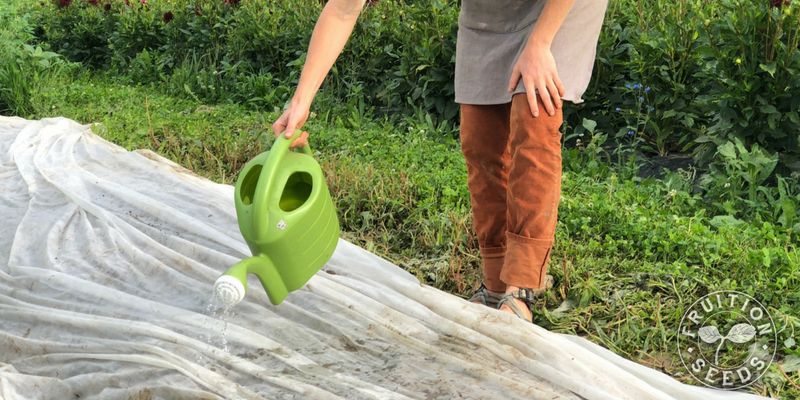
We use floating row cover to exclude insects from brassicas and cucurbits, extend the season of greens and germinate carrots quickly.
Now, let’s talk row cover.
For germinating roots, we don’t use fresh, new floating row cover. Instead, we reach for row cover that has been through the seasons. At Fruition, row cover has three main lives:
~ As fresh, hole-free row cover, we use it as insect exclusion on brassicas and cucurbits.
~ Once it has a few holes, we use it as season extension on greens.
~ Once it is even more tattered, it becomes root germination material.
~ Once it is too tattered even more germinating roots, we finally send it to the landfill.
So yes, use floating row cover but by all means, don’t use brand-new row cover unless you have to.
Lay it down in an even layer, right on the soil, and weight the edges every few feet with rocks at arm’s length or sandbags for less chance of tear.
Once we’ve sown carrots, we lay the row cover down and immediately water them in. The row cover brilliantly distributes the water weight/pressure, whether you’re watering them by hand or the rain is falling, no matter how hard. Your goal is for the surface of the soil to always be moist. Watering in the evening ensures a long, lovely night of moisture surrounding the seeds, compared to morning or mid-day when heat and evaporation remove moisture more quickly.
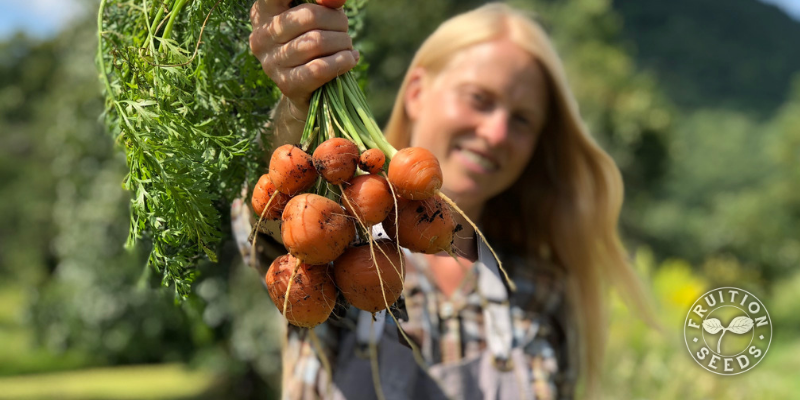
Sow your final succession of carrots, like these Paris Market carrots perfect for containers, about eight weeks before first frost.
3. Timing is Everything
Carrots can be sown early spring through late summer. The cooler the soil temps, the longer germination will take and the more weeding you’ll likely do! Sow your fall succession of full-size carrots about eight weeks before first frost. For us here in Zone 5, early August is final call!
Carrots are not easy to grow, Friends. But with a few keys to keep in mind, you’ll gain confidence and be delighted by an abundance of sweet, tender roots in your life, better than anything you’ll ever find in a grocery store.
It’s kinda the best feeling in the world, plucking carrots from rich, sweet soil.
And knowing you’re not alone .
Sow Seeds & Sing Songs,

and the Many Beings of Fruition
ps
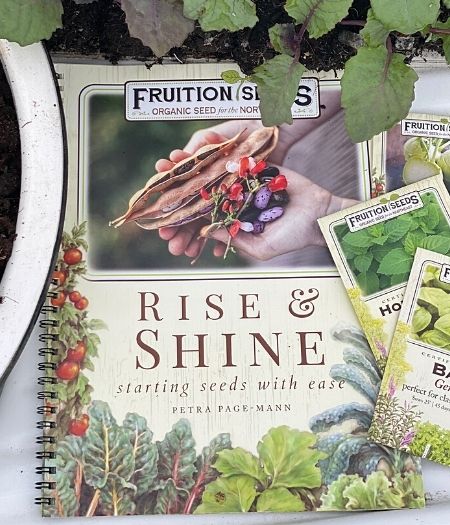
enjoy Fruition's free online
Growing Library!
Enjoy all Fruition's growing resources including:
~ growing guides ~
~ ebooks ~
~ planting charts ~
~ infographics ~
All in one place, viewable and download-able anytime...
~When you join us, check your inbox for your welcome & access info! Stay tuned for our weekly organic gardening tips & inspiration, as well~

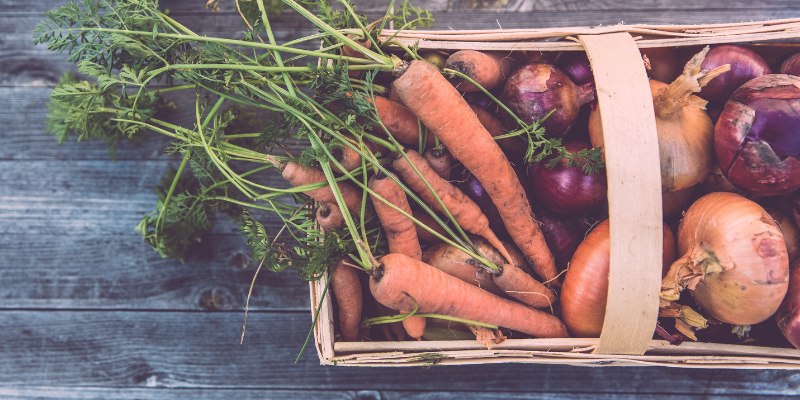
How to prevent carrot plants from pests?
What is eating or affecting your carrots?
I view something really interesting about your blog so I saved to bookmark
I like the writing style of this blog, it is very clear and very informative
Thank you Shakira! We are glad you enjoyed it. Thanks for being a part of the Fruition Community!
Melissa
I like the writing style of this blog, it is very clear and very informative
I just came to this blog for the first time, and I am very interested in the information presented, I will come back another time
Excellent blog!
You did amazing job.
In Upstate NY with this warm winter, if the ground isn’t frozen, are you planting carrots now? Or anything else?
Hi David, here in the finger lakes we start carrots 2-3 weeks before last frost through mid-July. Happy Sowing!